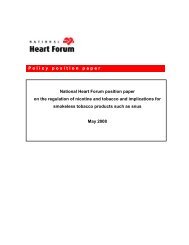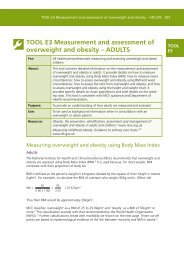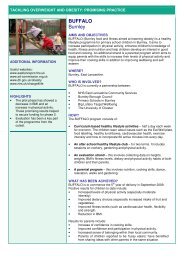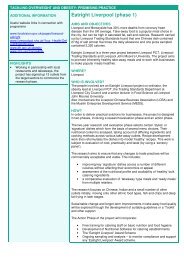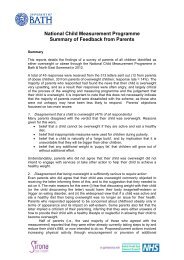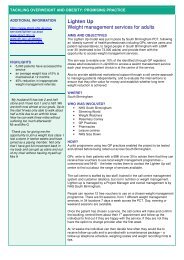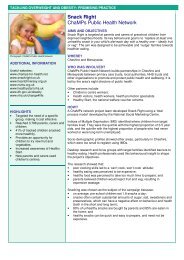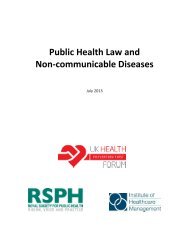The Challenge of Non-Communicable Diseases and Road Traffic ...
The Challenge of Non-Communicable Diseases and Road Traffic ...
The Challenge of Non-Communicable Diseases and Road Traffic ...
Create successful ePaper yourself
Turn your PDF publications into a flip-book with our unique Google optimized e-Paper software.
An Overview 45<br />
financing <strong>and</strong> external financing that is allocated<br />
to specific interventions rather than to systems<br />
strengthening [286].<br />
Community-Based Interventions<br />
<strong>The</strong> community, whether defined socially or spatially,<br />
can be a good hub for health promotion in Africa, as<br />
elsewhere [277]. Community-based demonstration<br />
projects for CVD prevention have been shown to be<br />
effective in achieving reduced rates <strong>of</strong> CVD <strong>and</strong> risk<br />
factors, <strong>and</strong> given the common risk-factor approach<br />
these have been exp<strong>and</strong>ed to focus to NCD prevention<br />
[287-288]. <strong>The</strong> approach is based on low-cost lifestyle<br />
modifications <strong>and</strong> community participation <strong>and</strong> is<br />
generalizable, with the general principles the same regardless<br />
<strong>of</strong> the degree <strong>of</strong> development <strong>of</strong> the country<br />
[289-290]. Table 10 summarizes the main components<br />
<strong>of</strong> a community-based intervention program.<br />
Any demonstration project to pilot <strong>and</strong> evaluate<br />
the approach in a country context should work<br />
closely with national policy makers throughout, with<br />
a view to scaling-up <strong>and</strong> country-wide dissemination.<br />
Shifting from project to program <strong>and</strong> ensuring<br />
sustainability can be challenging, requiring investment<br />
in the skills <strong>and</strong> capacity <strong>of</strong> community-based<br />
organizations <strong>and</strong> public health systems during a<br />
phased transition [291].<br />
A Focus on Determinants<br />
Programs need to take into account social determinants<br />
– the causes underlying causes – which influence<br />
risk factors <strong>and</strong> behaviors; for example, gender<br />
norms have implications for health prevention <strong>and</strong><br />
care strategies in Africa [130, 295]. <strong>The</strong> discussion<br />
on burden <strong>of</strong> disease in Section 2 highlighted clear<br />
variations in the risk factors between women <strong>and</strong><br />
men; thus policies, interventions, <strong>and</strong> monitoring <strong>of</strong><br />
impact need to be gender sensitive. Both the health<br />
<strong>and</strong> non-health sectors have roles to play in improving<br />
day-to-day living conditions <strong>and</strong> addressing<br />
the inequitable distribution <strong>of</strong> power, money, <strong>and</strong><br />
resources so that people have greater health opportunities<br />
[296]. Investing in early child development<br />
<strong>and</strong> compulsory education at primary <strong>and</strong> secondary<br />
levels can have strong returns, <strong>and</strong> comprehensive<br />
<strong>and</strong> universal social protection strategies would<br />
support a level <strong>of</strong> income for healthy living [128].<br />
Helping people change their behaviors can be difficult,<br />
<strong>and</strong> needs to take account <strong>of</strong> the challenges<br />
that face people <strong>and</strong> underst<strong>and</strong>ing what motivates<br />
<strong>and</strong> influences their behaviors <strong>and</strong> choices [297].<br />
Successful NCD preventive interventions do make<br />
it feasible for people, including those in poverty,<br />
to adopt healthier lifestyles. Making the healthier<br />
choice the easier choice can be achieved through the<br />
TABLE 10: Components <strong>of</strong> a Community-Based Program for NCD Prevention<br />
Diagnosis<br />
Planning<br />
Communication<br />
Interventions<br />
Health-Supporting<br />
Environments<br />
Evaluation<br />
A good underst<strong>and</strong>ing <strong>of</strong> the community’s needs, practices, beliefs <strong>and</strong> priorities, developed in<br />
close collaboration with the community itself<br />
Carefully planned activities that take account <strong>of</strong> the community context, including primary health<br />
care services, voluntary organizations, food shops, restaurants, work sites <strong>and</strong> schools, that link<br />
with any existing strategies for identifying <strong>and</strong> targeting people at high risk, <strong>and</strong> which build<br />
upon the existing skills <strong>and</strong> resources within the community<br />
Messages <strong>and</strong> interactions to provide information <strong>and</strong> reinforce behavior change, using the most<br />
effective channels (media, peer-to-peer, opinion leaders, <strong>and</strong> so forth)<br />
Equipping practitioners with the necessary skills <strong>and</strong> competencies to carry out cost-effective<br />
interventions, ensuring the community is exposed to an effective dose <strong>of</strong> the intervention<br />
Working with community organizations <strong>and</strong> sectors such as education, transport, environment,<br />
<strong>and</strong> spatial planning to help change social <strong>and</strong> physical environments to make them more healthsupporting<br />
<strong>and</strong> conducive to health <strong>and</strong> healthy life-styles<br />
Monitoring the change process <strong>and</strong> evaluating the interventions <strong>and</strong> program objectively <strong>and</strong> in<br />
terms <strong>of</strong> the community’s perceptions, <strong>and</strong> including an economic component in the evaluation<br />
where possible; disseminating results so that other communities can benefit<br />
Source: Authors, adapted from [275, 292-294]



